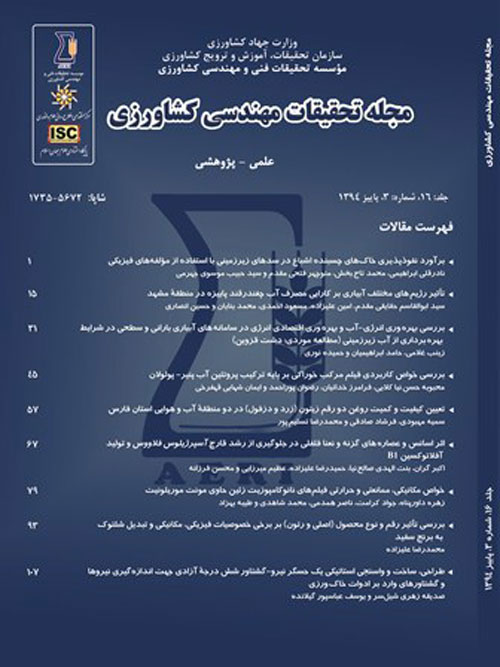The Effect of Harvesting Method on Losses for Two Rice Varieties in Khouzestan Province
Author(s):
Abstract:
Multistage and semi-mechanized harvesting of rice in Khouzestan province, Iran, causes much loss. Depending on available facilities and conditions, either spike-tooth or rasp-bar cylinders are employed with either direct or indirect combine harvesting methods. The present research studied the effect of these different harvesting methods on the amount of losses in two rice varieties in 2001-2002 at Shavour Agricultural Research Station in Khouzestan province. The experiment was devised as a strip-plot with a randomized complete block design with two variables (harvesting method, variety) and three replications. The vertical axis variable harvesting methods were: indirect harvesting (manual) plus threshing by rasp-bar cylinder combine; indirect harvesting plus with threshing by spike-tooth cylinder combine; direct harvesting with threshing by rasp-bar cylinder combine, direct harvesting with threshing by spike-tooth cylinder combine. The horizontal axis variables were: high yield LD183 rice variety; qualitative local RedAnboury rice variety. Analysis of the losses for the two years showed a significant difference between years for harvesting methods and their interactions but no significant difference between varieties. A comparison of averages showed that losses for the first year were greater at 3.34% than for the second year at 2.08%. However, average losses for the Red Anboury variety were 2.71% and 2.74% for the LD183 variety. For both direct and indirect harvesting methods, average losses for harvesting by spike-toothcylinder combine were 1.73%, which was less than the 3.68% for the rasp-bar cylinder combine. The spiketooth cylinder combine produced the least amount of loss over the two varieties. Indirect harvesting of LD183 with threshing by rasp-bar cylinder combined in the first year produced the greatest average loss at 5.42%. Indirect harvesting of Red Anboury with threshing by spike-tooth cylinder combine in second year produced the lowest average loss at 1.48%. There was no significant difference between harvestingmethods for quality of loss (broken rice rate) but there was a large significant difference by year with 45.6% for the second year and only 18.9% for the first year. This loss was also significant by variety with LD183 averaging 34.2% broken rice and Red Anboury averaging 27.6%. Over all harvesting methods,LD183 had greater broken rice rates.
Keywords:
Language:
Persian
Published:
Journal of Agricultural Engineering Research, Volume:9 Issue: 3, 2008
Page:
89
https://magiran.com/p780371
دانلود و مطالعه متن این مقاله با یکی از روشهای زیر امکان پذیر است:
اشتراک شخصی
با عضویت و پرداخت آنلاین حق اشتراک یکساله به مبلغ 1,390,000ريال میتوانید 70 عنوان مطلب دانلود کنید!
اشتراک سازمانی
به کتابخانه دانشگاه یا محل کار خود پیشنهاد کنید تا اشتراک سازمانی این پایگاه را برای دسترسی نامحدود همه کاربران به متن مطالب تهیه نمایند!
توجه!
- حق عضویت دریافتی صرف حمایت از نشریات عضو و نگهداری، تکمیل و توسعه مگیران میشود.
- پرداخت حق اشتراک و دانلود مقالات اجازه بازنشر آن در سایر رسانههای چاپی و دیجیتال را به کاربر نمیدهد.
In order to view content subscription is required
Personal subscription
Subscribe magiran.com for 70 € euros via PayPal and download 70 articles during a year.
Organization subscription
Please contact us to subscribe your university or library for unlimited access!


